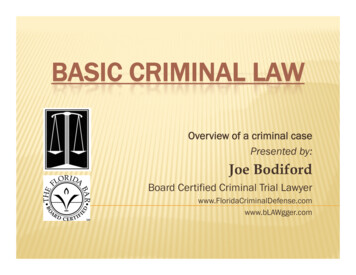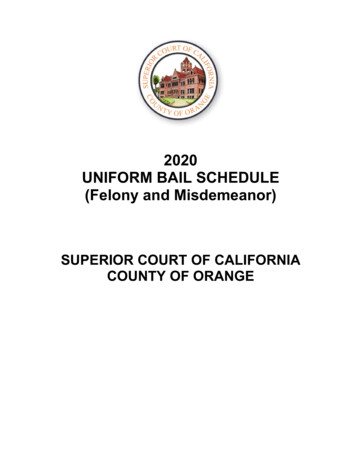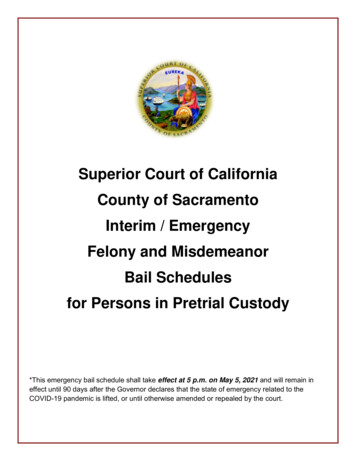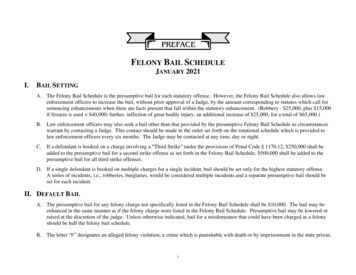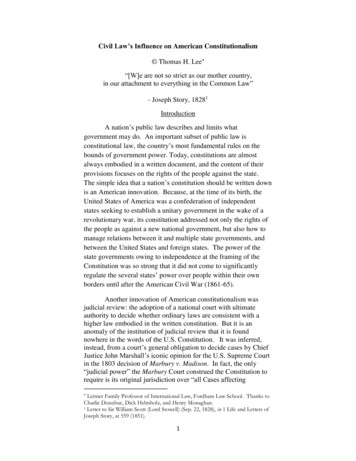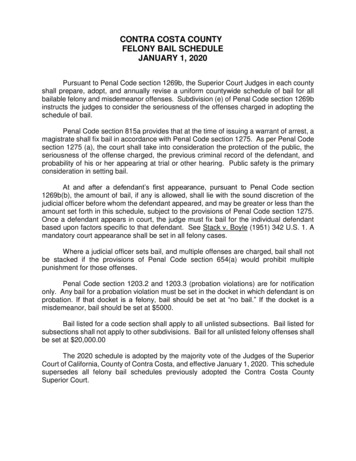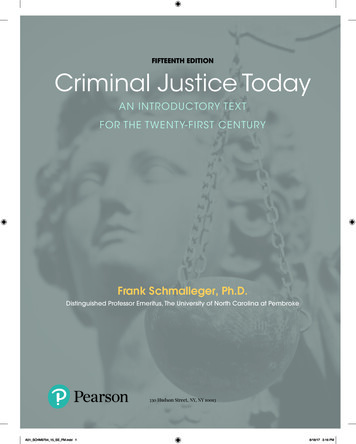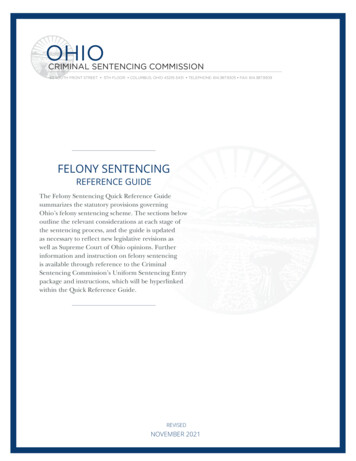
Transcription
OHIOCRIMINAL SENTENCING COMMISSION65 SOUTH FRONT STREET 5TH FLOOR COLUMBUS, OHIO 43215-3431 TELEPHONE: 614.387.9305 FAX: 614.387.9309FELONY SENTENCINGREFERENCE GUIDEThe Felony Sentencing Quick Reference Guidesummarizes the statutory provisions governingOhio’s felony sentencing scheme. The sections belowoutline the relevant considerations at each stage ofthe sentencing process, and the guide is updatedas necessary to reflect new legislative revisions aswell as Supreme Court of Ohio opinions. Furtherinformation and instruction on felony sentencingis available through reference to the CriminalSentencing Commission’s Uniform Sentencing Entrypackage and instructions, which will be hyperlinkedwithin the Quick Reference Guide.REVISEDNOVEMBER 2021
CONTENTSUniform Sentencing Entry (USE) . . . . . . . . . . . . . . . . . . . . . . . . . . . . . . . . . . . 1Purpose & Principles of Criminal Sentencing. . . . . . . . . . . . . . . . . . . . . . . . 2Seriousness & Recidivism Factors: Consider in Every Case . . . . . . . . . . . . 3Pretrial Diversion . . . . . . . . . . . . . . . . . . . . . . . . . . . . . . . . . . . . . . . . . . . . . . . 4Intervention In Lieu of Conviction . . . . . . . . . . . . . . . . . . . . . . . . . . . . . . . . . 4Discretionary Prison Terms and Community Control . . . . . . . . . . . . . . . 5Targeted Community Alternatives to Prison (TCAP) . . . . . . . . . . . . . . . . . . 8 .Technical Violation/Community Control Violator Caps . . . . . . . . . . . . . . 8Mandatory Prison Terms . . . . . . . . . . . . . . . . . . . . . . . . . . . . . . . . . . . . . . . . . 9Indefinite & Definite Sentencing . . . . . . . . . . . . . . . . . . . . . . . . . . . . . . . . . 12Sentencing Considerations & Advisements . . . . . . . . . . . . . . . . . . . . . . . . 13.Registration Requirements . . . . . . . . . . . . . . . . . . . . . . . . . . . . . . . . . . . . . . 17Financial Sanctions . . . . . . . . . . . . . . . . . . . . . . . . . . . . . . . . . . . . . . . . . . . . . 19Release & Sentence Reduction Mechanisms . . . . . . . . . . . . . . . . . . . . . . . 20Felony Sentencing Table . . . . . . . . . . . . . . . . . . . . . . . . . . . . . . . . . . . . . . . 24
UNIFORM SENTENCING ENTRY (USE)The complex, intricate process of felony sentencing in Ohio makes ensuring clear,comprehendible sentences of the utmost import for the administration of justice andpromoting confidence in the system. As such, Chief Justice Maureen O’Connor askedthe Commission to convene an ad hoc committee on uniform sentencing entry (USE).The committee developed a USE that prescribes the most clear and concise minimumlanguage required to comply with Criminal Rule 321 and existing case law, and establishesstandardized, common data essential for identifying relationships and trends common toall felony courts.2Further, there are certain important elements that precede sentencing but are notessential to the minimum language required for a USE – especially in light of recentSupreme Court of Ohio decisions and the ever-changing statutory provisions regardingsentencing. Thus, the committee also developed companion method of conviction (plea)entries, as well as entries memorializing the other manners in which a felony criminal casemay be disposed.Additionally, throughout the work of the committee, there was a common thread to thediscussion centered squarely on the notion of what the committee coined “good civics.”In other words, there are a number of standardized documents and notices that are usedwith regularity and recommended for use but not required by law for sentence or otherdisposition. The committee agreed that the Commission should obtain these documentsfrom individual jurisdictions and serve as a repository to make them available.After approximately one year of work and collaboration with the Ohio Common PleasJudges Association, Ohio Prosecuting Attorneys Association, Supreme Court of Ohio,Ohio Judicial Conference, Ohio Clerk of Courts Association, Ohio Chief ProbationOfficers Association, and Ohio felony court administrators, among others, a “package” ofdocuments for felony sentencing was endorsed, including: A USE; Method of conviction entries; and “Good civics” forms and notices.The goal, in part, was to design a “living document” that will be adapted as law, rules, andpractices dictate. Accordingly, the Commission is monitoring legislation and SupremeCourt of Ohio case decisions to keep the USE and associated documents current with anynecessary changes, notifying practitioners of those changes, and working with jurisdictionsto provide training as the entry is adopted.Judges and courts are in various stages of implementing the USE and associateddocuments. Additional information on the topics covered in the Felony Sentencing Guidecan be found in the USE package criminal/CriminalProcedure.pdfFor details, email Sara.Andrews@sc.ohio.govThe latest versions of the Uniform Sentencing Entry and the Method of Conviction and Good Civicsforms are available at ohiosentencingdata.info/courtsFelony Sentencing Reference Guide Revised: November 2021 sc.ohio.gov/boards/sentencing Page 1
The adoption of the package of felony sentencing documents is the first step to begin standardized,aggregate felony sentencing data collection in Ohio – the Ohio Sentencing Data Platform.It provides the foundation to create a timely, accurate, comprehensive, searchable, andshared (felony) sentencing database to help inform decision making and give judges thetools and information needed to impose sentences in accordance with the purposes andprinciples of felony sentencing. We believe we can do this in a way that is efficient, reducesduplication, and does not fiscally or administratively burden local government.The Sentencing Commission has partnered with the University of Cincinnati to developthe Ohio Sentencing Data Platform, which includes a web-based application courts canuse to create their sentencing entries in USE format. This application integrates withexisting court practice to minimize workload impact in creating a sentencing entry. Theapplication is currently being tested, with plans to roll the application out to additionalcourts in the summer of 2021.Courts and practitioners interested in more information on the USE package and theOhio Sentencing Data Platform can visit ohiosentencingdata.info or contact:SARA ANDREWSDirector, Ohio Criminal Sentencing CommissionSara.Andrews@sc.ohio.govPURPOSES & PRINCIPLES OF SENTENCING [R.C. 2929.11(A)]Overriding Purposes:To protect the public fromfuture crime by the offender andothers, to punish the offender,and to promote the effectiverehabilitation of the offenderwhile “using the minimumsanctions that the courtdetermines accomplish thosepurposes without imposing anunnecessary burden on state orlocal government resources.”Principles: Always consider the need for incapacitation,deterrence, rehabilitation of the offender, andrestitution to the victim and/or the public[R.C. 2929.11(A)]. Sentences should be commensurate with, andnot demeaning to, the seriousness of offender’sconduct and its impact on the victim, andconsistent with sentences for similar crimes bysimilar offenders [R.C. 2929.11(B)]. Courts shall not sentence based on the offender’srace, ethnicity, gender, or religion [R.C. 2929.11(C)].Felony Sentencing Reference Guide Revised: November 2021 sc.ohio.gov/boards/sentencing Page 2
SERIOUSNESS & RECIDIVISM FACTORS: CONSIDER IN EVERY CASEThe court must weigh the following factors, if present, as well as any other relevant factors.A. OFFENDER’S CONDUCT MORE SERIOUS [R.C. 2929.12(B)] Injury exacerbated by victim’s physical or mental condition or age; Victim suffered serious physical, psychological, or economic harm; Offender held public office or position of trust related to the offense; Offender’s occupation, elected office, or profession obliged the offender to preventthe offense or to bring those committing it to justice; Offender’s professional reputation or occupation, elected office, or professionfacilitated the offense or is likely to influence others’ conduct; Offender’s relationship with the victim facilitated the offense; Offender acted for hire or as part of organized criminal activity; Offender was motivated by prejudice based on race, ethnicity, gender, sexualorientation, or religion; and In a domestic violence or assault case, offender is parent or custodian, the victimwas a family or household member, and the offense was committed in the vicinity ofone or more children other than the victim.B. OFFENDER’S CONDUCT LESS SERIOUS [R.C. 2929.12(C)] Victim induced and/or facilitated the offense; Offender acted under strong provocation; Offender did not cause or expect to cause physical harm to person or property; and Substantial grounds exist to mitigate the offender’s conduct, even if they do notconstitute a defense.C. OFFENDER’S RECIDIVISM MORE LIKELY [R.C. 2929.12(D)] Offense was committed while on bail, awaiting sentencing, on felony communitycontrol or post-release control (PRC), or after PRC unfavorably terminated; Offender has a history of criminal convictions or juvenile delinquencyadjudications; Offender has not responded favorably to sanctions previously imposed in adult orjuvenile court; Offender shows pattern of alcohol/drug use related to offense and doesn’tacknowledge it or refuses treatment; and Offender shows no genuine remorse.D. OFFENDER’S RECIDIVISM LESS LIKELY [R.C. 2929.12(E)] Offender has no prior juvenile delinquency adjudication and/or no prior adultconviction; Offender has led a law-abiding life for a significant number of years; Offense was committed under circumstances unlikely to recur; and Offender shows genuine remorse.E. OFFENDER’S VETERAN STATUS [R.C. 2929.12(F)]Felony Sentencing Reference Guide Revised: November 2021 sc.ohio.gov/boards/sentencing Page 3
PRETRIAL DIVERSIONCounty prosecuting attorneys are permitted to establish pretrial diversion programs understandards approved by the presiding judge in their jurisdiction pursuant to R.C. 2935.36.Programs and availability may vary by jurisdiction but are generally aimed at helpingdefendants with a low risk for recidivism avoid criminal conviction. Model diversionapplication and acceptance entries are available as part of the uniform sentencing entry(USE) package. Pretrial diversion eligibility is determined by the charge or nature of the offense oroffenses involved [R.C. 2935.36(A)(1-5)]. Defendants accepted into diversion must, in writing, waive their speedy trial rights,agree to tolling of the statute of limitations, and agree to pay any supervision feesestablished under the program [R.C. 2935.36(B)]. Victims of the criminal offenses and the arresting officers may object to offender’sacceptance [R.C. 2935.36(C)]. Successful completion of the diversion program results in a dismissal of the chargesagainst the defendant. Unsuccessful termination from the program results in thedefendant being brought to trial on the charges [R.C. 2935.36(D)].INTERVENTION IN LIEU OF CONVICTIONDefendants who allege that one of four types of conditions were a factor contributing totheir commission of the offenses with which they are charged may request that the trialcourt grant intervention in lieu of conviction (ILC). If ILC is granted and successfullycompleted, the defendant may have the charges against them dismissed and are eligibleto have those charges sealed as a dismissal [R.C. 2951.041]. Model ILC application andacceptance entries are available as part of the USE package. Recent changes to the ILCstatute made in 133 GA House Bill 1, effective April 12, 2021, are noted in bold.Procedure: The application requesting intervention in lieu must contain a waiver ofapplicable speedy trial rights and an allegation that one of the following contributed totheir commission of the criminal offense(s): Drug or alcohol use by the defendant; Mental illness; Intellectual disability; or The defendant was a victim of human trafficking [R.C. 2905.32] or compellingprostitution [R.C. 2907.21].The court may then schedule a hearing to determine the defendant’s eligibility for ILC.A hearing is mandatory if the defendant alleges drug or alcohol use as a factor. If ahearing is ordered, the court must order the defendant assessed for program eligibilityand a recommended intervention plan. For allegations of drug or alcohol use, thisincludes assessment by an addiction services provider [R.C. 2951.041(A)(1)]Whether an defendant is eligible for ILC is determined pursuant to R.C. 2951.041(B)(1-10), andinclude consideration of defendant’s criminal history, the nature of the offenses chargedand the victims involved, the assessment ordered, and whether ILC would reduce thelikelihood of recidivism and not demean the seriousness of the offense.Felony Sentencing Reference Guide Revised: November 2021 sc.ohio.gov/boards/sentencing Page 4
All felony sex offenses are excluded from ILC eligibility. At the hearing, the court shallpresume ILC is appropriate, and must state the reasons for a denial of ILC in a writtenentry.If the defendant is found appropriate for ILC, the court accepts but does not file, a guiltyplea and speedy trial rights waiver from them, and stays all criminal proceedings, placingthem under supervision for completion of the intervention plan imposed for at least one,but up to five years. The intervention plan must include drug and alcohol abstinence,treatment, and testing, along with other conditions the court finds appropriate[R.C. 2951.041(C-D)].Successful completion of ILC results in dismissal of the charges, sealable immediately asdismissals pursuant to R.C. 2953.51-.56. Failure to comply with conditions imposed may resultin revocation and the defendant being found guilty pursuant to the plea and sentenced[R.C. 2951.041(E-F)].DISCRETIONARY PRISON TERMS AND COMMUNITY CONTROLUnless a prison term is mandatory for an offense or specification, the sentencing courthas the option to either place a defendant under the court’s supervision on communitycontrol with a reserved prison sentence, or to impose a prison term for the offense. Theform and structure of the Uniform Sentencing Entry and its instructions lead courtsthrough the necessary considerations and findings when imposing sentences.A. COMMUNITY CONTROLCourts have authority, based on the offense involved, to place a defendant under a periodof supervision by their probation department with appropriate residential, nonresidential,and/or financial sanctions as conditions of that community control. The judge must selecta reserved prison term from the sentencing range for the offense in R.C. 2929.14 and informthe defendant of the prison term that could be imposed if they violate their communitycontrol. Effective Sept. 30, 2021, the sentencing judge is no longer required to select aspecific prison term – instead, the court is required to inform the defendant of the rangeof prison terms available for the offense [R.C. 2929.19(B)(4)].The sentencing court can reduce the period of community control or impose lessrestrictive sanctions for defendants who fulfill the conditions of their supervision “in anexemplary manner” [R.C. 2929.15(C)].If the defendant is found to be in violation of community control, pursuant to R.C. 2929.15(B)(1)the court can: Extend the defendant’s period of supervision, up to a maximum of five years; Impose additional or more restrictive sanctions; and/or Impose a prison term for the violation, subject to the limitations and rules inR.C. 2929.15(B)(1)(c)(i-iii) and (3). The prison term cannot exceed the specific term reserved at the originalsentencing hearing. The court has discretion to reduce the reserved prisonterm originally imposed. Effective Sept. 30, 2021, the prison term must be fromthe range of terms available for the offense that the defendant was notified ofat the original sentencing hearing.Felony Sentencing Reference Guide Revised: November 2021 sc.ohio.gov/boards/sentencing Page 5
R.C. 2929.15(B)(2)(c) [moved to (B)(1)(c)(iii) effective Sept. 30, 2021] gives thecourt discretion to impose a prison term for violations during their communitycontrol supervision more than once. The changes made to R.C. 2929.15 also provide for prison to be used as asanction for non-technical community control violations, violations of law, orleaving the state without permission. The prison term imposed must be fromthe range of prison terms reserved for the offense, but the provisions ofR.C. 2929.15(B)(2)(b) providing for credit against the offenders remaining time oncommunity control do not apply under a literal reading of the statute.1Right of Appeal: If a prison term is imposed for a defendant qualifying for mandatorycommunity control under R.C. 2929.13(B)(1)(a), the defendant has appeal of right underR.C. 2953.08(A)(2) unless the court specifies one or more factor found in R.C. 2929.13(B)(1)(b).B. RESIDENTIAL SANCTIONSIncluding, but not limited to R.C. 2929.16, (see R.C. 2929.01 for definitions): Community-based correctional facility (CBCF) for up to six months; Jail or minimum-security jail for up to six months (or up to one year for certainF-4 OVIs); Halfway house, no stated time limit; and Alternative residential facility: another place for employment, training, education,treatment, etc.C. NONRESIDENTIAL SANCTIONSIncluding, but not limited to R.C. 2929.17, (see R.C. 2929.01 for definitions):1 Day reporting: report to an approved location to participate in work, training,treatment, etc; House arrest and/or electronic monitoring and/or continuous alcohol monitoring; Community service for up to 500 hours for felonies, which may be imposed onindigent and non-indigent persons; the 40-hour/month cap is no longer thelaw, community service is credited against financial sanctions imposed at judge’sdiscretion; Drug treatment: inpatient, outpatient, or both; court determines level of security; Drug- and alcohol-use monitoring, including random drug testing; Intensive probation supervision; frequent contact with supervising officer, etc.; Basic probation supervision, subject to conditions set by the court; Monitored time: under court control, subject to no conditions other than leading alaw- abiding life; Curfew; Employment – obtain or retain a job;Note that the provisions allowing for imposition of a prison term followed by continued communitycontrol conflict with existing case law on criminal sentencing following SB2. Prison and communitycontrol have historically been treated as mutually exclusive options, and the imposition of both a prisonterm and a community control sanction on a given count has been repeatedly rejected by the SupremeCourt of Ohio. See, e.g., State v. Anderson, 143 Ohio St.3d 175, 2015-Ohio-2089 and State v. Hitchcock, 157Ohio St.3d 215, 2019-Ohio-3246.Felony Sentencing Reference Guide Revised: November 2021 sc.ohio.gov/boards/sentencing Page 6
Education or training; Victim-defendant mediation, with the victim’s prior consent; License violation report: Inform an agency granting a business or professionallicense of the violation; Counseling generally, in particular, if a parent or custodian sentenced for domesticviolence or assault involving a family or household member committed in thevicinity of a child other than the victim; and Sex defendant treatment program (for an defendant convicted of unlawful sexualconduct with a minor committed while the defendant is 21) [R.C. 2929.17(O)].D. “MANDATORY” COMMUNITY CONTROLF-4s, F-5s, and “Division B” drug offenses [R.C. 2929.13(B)(1)(a)]:Community control is mandatory, subject to R.C. 2929.13(B)(1)(b) below, if the most seriouscharge is an F-4 or F-5 that is not an offense of violence [R.C. 2901.01(A)(9)] or qualifyingassault offense [R.C. 2929.13(K)(4)] and the defendant: Did not have prior felony at any time or prior misdemeanor offense of violencewithin two years; and The most serious charge against the offender at the time of sentencing is an F-4 or F-5.Under [R.C. 2929.13(B)(1)(b)] the sentencing court has discretion to impose a prison term if itfinds any of the following: Physical harm to a person; Attempt or actual threat of physical harm to a person with a deadly weapon; Attempt or actual threat of physical harm to a person, plus prior conviction forcausing such harm; Offense related to public office/position held; position obligated offender toprevent it or to bring others to justice; or offender’s reputation/position facilitatedthe crime or likely to influence others; Offense was for-hire or part of organized criminal activity; Offense was a sex offense; Offender served a prior prison term or was in prison at time of offense; Offense was committed while offender was under community control or on bail orbond; or Offender committed the offense while in possession of a firearm.E. NO PRESUMPTIVE SENTENCEF-3s generally or “Division C” drug offenses: courts are directed to fashion an appropriatesentence based on the purposes and principles of sentencing as detailed in R.C. 2929.11 andR.C. 2929.12 [R.C. 2929.13(C)].Felony Sentencing Reference Guide Revised: November 2021 sc.ohio.gov/boards/sentencing Page 7
F. PRESUMPTIVE PRISON TERMSF-1s, F-2s, “in favor” drug offenses, and certain F-3, F-4, and F-5 offenses: there is apresumption that a prison term is the appropriate sentence for these categories ofoffenses [R.C. 2929.13(D)(1)]. To rebut presumption, the sentencing court must find that nonprison sanctions would both [R.C. 2929.13(D)(2)]: Adequately protect the public and punish the offender because the factorsindicating recidivism is less likely outweigh the factors indicating recidivism is morelikely; and Not demean seriousness of the offense because less-serious factors outweigh moreserious factors.Other offenses subject to a presumption in favor of a prison term are: In favor” drug offenses where specified in [R.C. Chapter 2925] Theft of firearm [R.C. 2913.02(B)(4)]; Certain GSI offenses [R.C. 2907.05(A)(4) or (B)]; F-3 importuning [R.C. 2907.07(F)(2)]; F-4 Possession of a Controlled Substance Analogue [R.C 2925.11(C)(8)(b)]; and F-5 Importuning [R.C. 2907.07(F)(3)].Right of Appeal: If the presumption is overcome and a prison term is not imposed (or if aprison term is imposed but judicial release is later granted) state has appeal of right[R.C. 2953.08(B)(1)].TARGETED COMMUNITY ALTERNATIVES TO PRISON (TCAP)TCAP is a voluntary program statewide following the passage of 133 GA HB 166. Moreinformation on TCAP is available at DRC’s website. In participating counties, F-5offenders (and effective Sept. 1, 2022, F-4 offenders as well) who are sentenced to aprison term 12 months cannot be sent to prison and instead must serve their sentencelocally, unless [R.C. 2929.34(B)(3)]: The offense was an offense of violence, a sex offense, a trafficking offense, or othermandatory prison term; The offender has a prior conviction for a sex offense or felony offense of violence; or The sentence is to be served concurrently to a prison-eligible felony offense.TECHNICAL VIOLATIONCOMMUNITY CONTROL VIOLATOR CAPSA “Technical violation” is a violation of the conditions of a community control sanctionimposed for a F-5, or for a F-4 that is not an offense of violence, is not a sexually orientedoffense, and to which neither of the following applies [R.C. 2929.15(E)]2:2In State v. Nelson, 162 Ohio St.3d 338, 2020-Ohio-3690, and State v. Castner, Slip Opinion No. 2020-Ohio4950, the Supreme Court of Ohio held that the determination of what constitutes a “technical violation”requires a totality of the circumstances analysis of relationship between the violations in question andthe overall goals of the community control sanction or condition. While these opinions were issued priorto the legislative definition of “technical violation” in 133 GA HB 1, the holdings may nonetheless beinstructive as to the analysis in R.C. 2929.15(E)(2).Felony Sentencing Reference Guide Revised: November 2021 sc.ohio.gov/boards/sentencing Page 8
The violation consists of a new criminal offense that is a felony or that is amisdemeanor other than a minor misdemeanor, and the violation is committedwhile under the community control sanction; or The violation consists of or includes the offender’s articulated or demonstratedrefusal to participate in the community control sanction imposed on the offender orany of its conditions, and the refusal demonstrates to the court that the offender hasabandoned the objects of the community control sanction or condition.The 90- or 180-day prison term imposed for a F-5 or F-4 technical violation cannot exceedthe time remaining on the defendant’s community control sanction or the reserved prisonterm for the charge. Time served for the technical violation must be credited againstthe defendant’s remaining time on community control. Effective Sept. 30, 2021, if thedefendant was serving a residential sanction of community control pursuant to R.C. 2929.16at the time of the technical violation, the time served for the technical violation must becredited against their remaining time on community control, their remaining time on theresidential sanction, and the reserved prison term in the case [R.C. 2929.15(B)(2)(b)(ii)].Defendants sent to prison for a technical violation sentence on an F-4 or F-5 shall bereturned to community control in the sentencing court at the completion of the sentence ifthere is any remaining time to be served on the community control sanction. Effective Sept.30, 2021, this return to community control will be at the discretion of the sentencing court.MANDATORY PRISON TERMSThe General Assembly frequently changes this list and doesn’t always include changesin R.C. 2929.13(F). Always check offense statute to determine if a specific penalty is mandated.Note: factors other than prior convictions that enhance the penalty for a given offense must bespecified in the indictment.A. AGGRAVATED MURDER OR MURDERThe court must impose a prison term specified by R.C. 2929.02 - 03. [R.C. 2929.13(F)(1)].B. F-1 OR F-2 WITH SPECIFIED PRIOR CONVICTIONSA prison sentence is mandatory when offender has a prior conviction for aggravatedmurder, murder, or any F-1 or F-2 offense [R.C. 2929.13(F)(6)].C. ASSAULT ON POLICE OFFICERSFelonious, aggravated, or simple assault when victim is a peace officer or BCI investigatorwho suffered serious physical harm [R.C. 2929.13(F)(4) and (13)]. Seven-year specification if offender shot at peace or corrections officer whilecommitting or attempting a homicide or assault offense [R.C. 2941.1412];[R.C. 2929.14(B)(1)(f)(i)]; and Five-year specification for aggravated vehicular homicide (AVH) with peace-officervictim [R.C. 2941.1414]; [R.C. 2929.14(B)(5)].Felony Sentencing Reference Guide Revised: November 2021 sc.ohio.gov/boards/sentencing Page 9
D. ASSAULT ON PREGNANT WOMENMandatory, within felony range, for felonious, aggravated, or simple assault if offenderknew of the pregnancy, with specification in [R.C. 2941.1423]; [R.C. 2929.13(F)(18)]; [R.C. 2929.14(B)(8)]. Mandatory 30-day jail term for misdemeanor violation with specification[R.C. 2929.24(G)].E. REPEAT VIOLENT OFFENDER SPECIFICATION (RVO)Defined as person who commits aggravated murder, murder, a violent F-1 or F-2, or an F-1or F-2 attempt of violence, with a prior conviction for one or more of the same[R.C. 2929.01(CC)]; [R.C. 2941.149]. Discretionary RVO time: if court elects the maximum from range for underlyingoffense and LWOP is not imposed, it may add one to 10 more years if the courtfinds under R.C. 2929.14(B)(2)(a)(i-v) that the prison term for the underlying offense is: Inadequate to punish the offender and protect the public (see recidivismfactors in [R.C. 2929.12(D) - (E)]); and Demeaning to seriousness of offense (see seriousness factors in [R.C. 2929.12(B-C)]). For F-2 offenses, the court also must find serious physical harm or attempt orthreat to do so.Under R.C. 2929.14(B)(2)(b), the court must impose the maximum prison termauthorized for the offense, plus an additional one to 10 years for RVO with threeor more RVO offenses in 20 years, including current, if LWOP not required orimposed.F. VIOLENT F-3 OFFENSES WITH PRIOR CONVICTIONSA prison term is mandatory for F-3 involuntary manslaughter or an attempt to commita violent F-2 offense involving attempted or actual serious physical harm when offenderhas a prior conviction for aggravated murder, murder, involuntary manslaughter, rape, orother F-1 or F-2 that involved causing or attempting to cause serious physical harm[R.C. 2929.13(F)(4) and (7)].G. CERTAIN SEX OFFENSES Any offense with a sexually violent predator (SVP) specification: under R.C. 2929.13(F)(2), (11), and (15) and R.C. 2971.03, at least two years to life for specification, consecutive tounderlying offense. Any rape: see R.C. 2929.13(F)(2) and our Rape Penalty Chart for range of sentences. Attempted rape, if victim 13 and, if completed, defendant would be classifiedas a sexual predator [R.C. 2929.13(F)(2)]; Five to 25 years for attempted statutory rape if offender 16 and victim 13[R.C. 2941.1418], [R.C. 2971.03(A)(3)(e)(ii) or (B)(2)(a)], [R.C. 2929.14(E)]; Ten years to life for attempted statutory rape if offender 16 and victim 10[R.C. 2941.1419], [R.C. 2971.03(A)(3)(e)(iii) or (B)(2)(b)]; and Fifteen years to life for attempted rape, if offender h
was a family or household member, and the offense was committed in the vicinity of one or more children other than the victim. B . OFFENDER’S CONDUCT LESS SERIOUS [R.C. 2929.12(C)] Victim induced and/or facilitate
